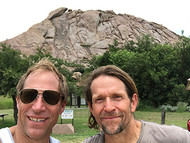My experience with Oklahoma rock
Posted by Fred Knapp on 24th Jan 2018
By Fred Knapp
In an odd sense, Oklahoma climbing has been on my radar since my youth. As a teenager I devoured climbing media, and I distinctly remember an article (in Outside magazine, I believe) about a prodigy who made breakthrough ascents on El Capitan, the Utah desert, and on difficult free routes—and whom few appreciated. Duane Raleigh, the story explained, honed his craft on a small dome jutting from the patchwork and furrowed fields of Oklahoma. The story stuck with me, as inspiration perhaps.
Years later, after moving to Boulder, I befriended a transplanted Oklahoma climber, Jimmy Ratzlaff, who retold the stories of his early Oklahoma days. Most stories centered around the gripping climbing at Quartz and adventures with Duane. The place, it seemed, left a mark on those who climbed there.
It would be decades before I actually journeyed to “the other granite state,” inspired to climb with Tony Mayse—an author who I enjoyed working with, though we’d only corresponding via emails and phone calls. With the upcoming publication of this new guide, I took the opportunity to travel with Sharp End’s designer, Sarah, to the midwest.
Quartz Mountain was, much as I suspected, an area stuck in the past. The routes are bold and slabby, meandering through sculpted weaknesses in near-perfect granite. Hillsides of granite boulders reside between farmland and small towns that smacked of rural America. We stopped at a grocery/diner where old men in overalls talked and played cards. In the midst of this Norman Rockwell setting sits Quartz.
The Wichita Mountain Wildlife Refuge caught me more off guard. This area was not part of my subconscious, as Jimmy and Duane left before the prominent development of the refuge—a massive expanse of preserved land, punctuated with reservoirs and streams, and overlain with a massive amount of granite detritus. My first thought was that this would be a mecca for bouldering. On our early morning drive, the first visitors we saw were, in fact, pad people approaching Mt. Scott via foot as fog closed the road.
Sculpted stone juts sporadically from the purlieu of the frontier setting. Long approaches on flat trails lead to granite walls, topped by hoodoos and pigmented with lichen. The climbing is not concentrated and the setting lonely (at least in the heat of early summer). The hardiness of pioneers seems to emanate from the landscape, and a certain hardiness is expected from the locals. This isn’t Rifle or Wall Street. The stone I experienced from Crab Eyes to the Narrows was impeccable and not suited to stereotypes. Steep sport climbs, splitter cracks, mixed routes following incipient cracks, and bold face climbs are intermixed at the crags.
Oklahomans are blessed to have these wonders, and fortunate to have someone like Tony—so enamored by these places, stones, and history. As we were guided crag to crag, moving from dawn to dusk, his enthusiasm and passion were undeniable, genuine, and moving. Tony’s superlatives and excitement overrode the dank heat. The Wichitas won us over.

